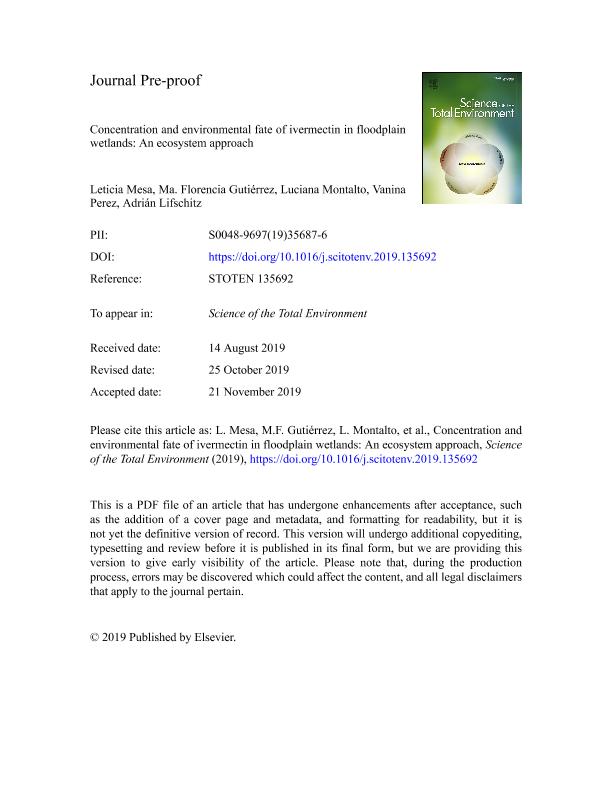Artículo
Concentration and environmental fate of ivermectin in floodplain wetlands: an ecosystem approach
Mesa, Leticia Mariana ; Gutiérrez, María Florencia
; Gutiérrez, María Florencia ; Montalto, Luciana
; Montalto, Luciana ; Perez, Vanina Andrea
; Perez, Vanina Andrea ; Lifschitz, Adrian Luis
; Lifschitz, Adrian Luis
 ; Gutiérrez, María Florencia
; Gutiérrez, María Florencia ; Montalto, Luciana
; Montalto, Luciana ; Perez, Vanina Andrea
; Perez, Vanina Andrea ; Lifschitz, Adrian Luis
; Lifschitz, Adrian Luis
Fecha de publicación:
03/2020
Editorial:
Elsevier
Revista:
Science of the Total Environment
ISSN:
0048-9697
Idioma:
Inglés
Tipo de recurso:
Artículo publicado
Clasificación temática:
Resumen
Ivermectin (IVM) is commonly used for broad control of endo- and ecto- parasites in cattle. In wetlands of the Parana Medio River, cattle has been treated repeatedly with IVM for years and concerns have been raised on possible presence of the drug in these ecosystems. A field study was conducted to assess concentration of IVM in two wetlands subjected to different cattle use and frequency of IVM injection. Concentration of IVM in roots of macrophytes, Chironomus sp., Coelotanypus sp., Brachymesia furcata (larvae), Dero sp., Hyalella sp., Hirudinea, Planorbidae, Boana pulchella (larvae), Aphyocharax anisitsi and Serrapinnus calliurus were shown for the first time. Total concentration of IVM in the wetlands, and concentration in cattle manure, sediment, water and macrophytes increased with the number of treated cattle and frequency of IVM injections. Accumulation of IVM in aquatic assemblages is alarming because these organisms fulfill a key role in food webs, constituting a serious risk to human health. Management strategies should be implemented by farmers to keep recently treated animals away from watercourses to reduce the introduction of IVM into aquatic systems.
Archivos asociados
Licencia
Identificadores
Colecciones
Articulos(CIVETAN)
Articulos de CENTRO DE INVESTIGACION VETERINARIA DE TANDIL
Articulos de CENTRO DE INVESTIGACION VETERINARIA DE TANDIL
Articulos(INALI)
Articulos de INST.NAC.DE LIMNOLOGIA (I)
Articulos de INST.NAC.DE LIMNOLOGIA (I)
Citación
Mesa, Leticia Mariana; Gutiérrez, María Florencia; Montalto, Luciana; Perez, Vanina Andrea; Lifschitz, Adrian Luis; Concentration and environmental fate of ivermectin in floodplain wetlands: an ecosystem approach; Elsevier; Science of the Total Environment; 706; 3-2020; 1-31
Compartir
Altmétricas



